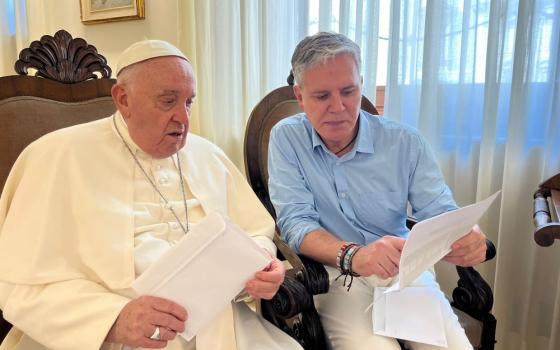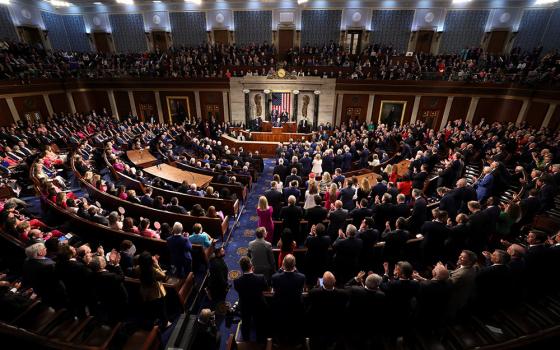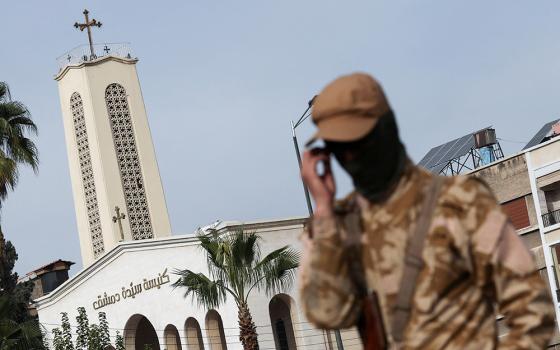
People gather to pray the Angelus with Pope Francis in St. Peter's Square at the Vatican Oct. 1. (CNS/Vatican Media)
The synod on synodality is awkwardly named, expressive of a reality that is lightly modeled in the past while in the present described as a journey, a process in formation even as it is being used.
The process itself is massive, global in scope and exhaustive in its attempt to hear voices from all quarters, at least at the start, without judgment or filters.
No surprise, then, that it is messy and promises only to get messier before clarity emerges. It is understandably jarring to those educated to believe the church is immutable, that certain "moral teachings" defined in the catechism are beyond change, that tradition means stasis and that unity translates as uniformity.
So what is Pope Francis up to? Why now?
Francis wasn't formed within the narrow and often crushing hierarchical culture of the Northern tier. He came to a position of authority through the crucible of the Latin American hierarchy's defining confrontations with historic ecclesiology. Continent-wide, as their documents show, church leaders in much of Latin America came to understand themselves in relationship to the poorest of the poor and the most marginalized.
Francis thus came to the papacy as a very different cleric from most of his predecessors. He came with new eyes able to see a path forward toward which a patient Spirit had been pointing for decades.
Change need not threaten the richness of Catholic history and tradition. It rather might signify a church alive and vibrant.
Peter Hebblethwaite, a singular Vaticanologist of the last century, noted in his book The Year of Three Popes that 1978, that time of unusual ecclesial turmoil in Rome, was reflective of "the pressures, anxieties and some of the dreams of the late 20th Century. The Church and the world do not stand still," he wrote. "Although an out-moded apologetic would have us believe otherwise, the papacy has changed and is changing."
Change need not threaten the richness of Catholic history and tradition. It rather might signify a church alive and vibrant.
Those who represent polar opposites when it comes to opinions on the synod — those who wish to destroy it at worst and those who wish to push for degrees of change likely beyond the possible — will dominate news cycles. They always do.
It is, however, wrong to see them as equally damaging of synodality. In the arc of history that runs through the 1962-65 Second Vatican Council and crosses the current synod, it is not those pressing the questions and advocating for change who have been declared heretical. Quite the opposite.
While the previous two papacies may have created hellish conditions for theologians and other thinkers and questioners in the church, it was nonetheless those who wished to regress who were formally excommunicated. Lefebvreites may have been reduced by that act to an irrelevant sect, but the feverish resistance to change they represented has morphed into countless forms and expressions. One of the most aggressive forms, a kind of Catholic fundamentalism wrapped in political and economic ideology, has emerged among the right wing of the U.S. church. The resistance, however, serves to highlight the need for a new direction.
Things change.
Advertisement
Early on, it was believed that the message of Jesus was reserved to Jews. Then gentiles were allowed only if they observed Jewish laws about circumcision and diet. Then the early leaders determined those rules did not apply.
Women were imagined as malformed males, even though God found fit to have them be the first to discover and declare the Easter miracle.
The church later regularly applied the adjective "perfidious" to Jews and prayed for their conversion. Then a council deemed that was wrong, and popes began visiting synagogues and describing Jews as brothers in Abraham.
The church and the culture change.
There was no salvation outside the church, until there was, and a pope invited other denominations and faiths to join him in prayer in Assisi, a practice that continued for decades.
LGBTQ people were described as "intrinsically disordered," a term that has quickly gone out of use. Now a pope says, when asked about homosexuality: "Who am I to judge?"
Slavery was once justified. Earning interest on loans was once forbidden.
The Earth, the church once insisted, was the center of the universe.
"The church and the world do not stand still." Nor do they stand in isolation from one another.
Change is threatening. It unravels the certainties that bring comfort. It calls into question aspects of culture that some see as immutable. It brings differences into sharp relief. It is unsettling.
Would the community, in lieu of change, remain convinced, for instance, that women are inferior to men? Would it remain convinced that slavery is justified? Would it continue to see Jews and others as enemies, or continue to insist that the Earth is the center of the universe? Would it allow the understanding of human behavior, sexuality, psychology, medicine, to remain stuck in some imagined time from which nothing can change?
Certainty does not require immutability. The certainty is assured, it is contained in its most compact form in the kerygma, the ancient statement of faith. As the late theologian Richard McBrien put it in his massive work Catholicism: "The message of the New Testament was always the message of the resurrection."
That's where the immutable certainty lies. And what of all those pesky issues causing anxiety and division? Perhaps Francis believes the church has reached a level of maturity where the questions can flow without retribution, where the messiness of the complex human family can be reflected in our deliberations. Where the awkward mouthful of syllables — synod on synodality — will come to model a new manner of life within the church.





